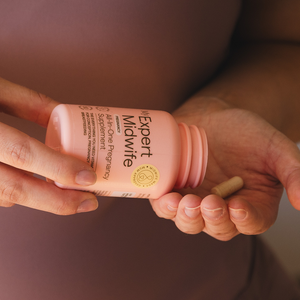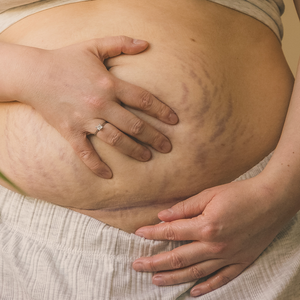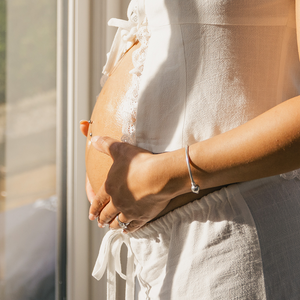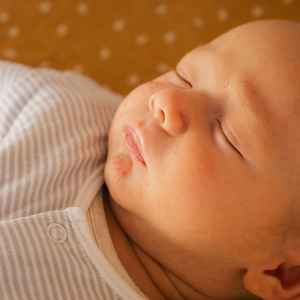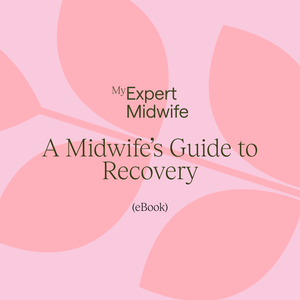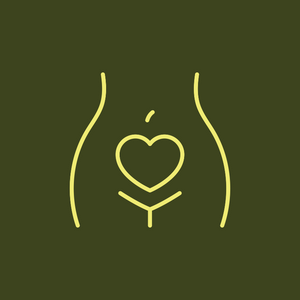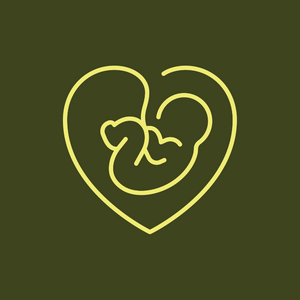The skin is the largest organ of the human body. This incredible structure has many functions, not least as the first line of defence for the immune system.
Your baby’s skin develops in the womb as your baby floats in the mineral and hormonally rich liquid environment of amniotic fluid. Once your baby is born and earthside, the skin must adapt to a completely different atmosphere in the air surrounding us.
Newborn and baby skin rashes and irritations are one of the most frequent queries new parents have. This blog will cover some of the most common complaints, the ones to seek medical advice about and how to care for the delicate beauty of a newborn baby’s skin.
Causes of baby rash
Going from the fluid-filled, warm, nutrient-rich environment inside the womb to a new environment of the air takes some getting used to for every baby's skin.
It is incredibly common for babies to suffer from one or even several skin complaints during their first year of life. So what are the leading causes of rashes in newborn babies?
- Adaptation to the air (after birth)
- Hormonal
- Friction
- Dampness
- Chemicals
- Fragrances
- Allergies
- Fabrics
- Heat or cold
- Viral or bacterial Infections
Many rashes on newborns are harmless, and as your baby grows, these skin conditions will likely disappear.
Some can be prevented and treated by using expertly developed baby skin products, such as our midwife-developed baby skincare range.
However, if you are ever concerned about any aspect of your baby’s skin, or your baby is unwell alongside having a rash, seek prompt medical advice from your Midwife, GP or healthcare professional.
Types of skin rashes
While this list is not exhaustive, it should give you an idea of the most common rashes that can occur on your baby:
1. Baby acne (Neonatal acne)
Alongside teenagers, babies are a group that can be affected by acne spots and pimples.
It is not caused by dirt or lack of cleaning!
It can affect up to 20% of newborns, appearing in the first few days of life and usually disappearing by the 2-month mark.
Some babies can, however, have acne up until two years of age. While the experts are unsure of the cause, a possible trigger of baby acne is the change in hormone levels.
While your baby is in the womb, they are exposed to higher levels of the mother’s hormones, but this drops after birth and may trigger acne.
Appearance:
They look like small white or yellow heads or spots with redness around them. You can usually find these rashes on the baby's neck, face, or chin.
Treatment:
Nothing! The best thing to do is leave any area affected alone. Milia usually disappear alone.
2. Milia
These tiny cysts or spots on your baby are often called ‘milk spots’, but don’t let the name confuse you; they have nothing to do with milk or feeding.
Dermatologists are not sure why milia happen, but it is thought that they are caused by a build-up of a protein called keratin in the immature skin of the newborn.
Unlike acne, they don’t form in a pore or have redness around them.
Appearance:
Up to 50% of babies develop these harmless white or yellow spots (depending on your baby’s skin colour), which usually appear on their face, chin and neck.
Treatment:
These tiny white spots aren’t itchy, don’t need any treatment and usually disappear quickly.
3. Nappy rash
Up to 50% of all babies will suffer from nappy rash at some point in their early babyhood or nappy-wearing journey.
Nappy rash can occur with disposable and reusable nappies, so no matter which option you choose for your baby, it’s important to stay vigilant and check for nappy rash routinely.
Check out our No Harm Bum Balm, perfect for soothing sore nappy rash.
Technically, nappy rash is a type of dermatitis (skin irritation) caused by the skin being in contact with wee and poo. Plus, irritation from the friction of the delicate baby’s skin next to the surface of their nappy.
It can happen more commonly if the baby is teething, is taking any medication or is otherwise unwell.
Appearance:
Red or inflamed skin around the bottom, genitals, upper legs and folds. It can also look like spots on your baby’s bum.
Treatment:
Prevention is always better than cure, where the nappy rash is concerned. Following these tips will help prevent nappy rash:
- Change nappies regularly, and with little girls, ensure you always wipe front to back.
- Dry the skin around your baby’s bottom very carefully, patting dry after baths and letting your baby have plenty of nappy free time.
- Use cotton wool and water or a fragrance-free, sensitive baby wipe when changing nappies.
- Use a specially formulated barrier cream, such as My Expert Midwife’s naturally-derived No Harm Bum Balm, to protect your baby’s skin and relieve soreness and redness, helping to reduce the incidence of nappy rash.
4. Meningitis
Meningitis is a potentially life-threatening infection (it can be both viral and bacterial) that affects the brain's lining.
Whilst rare, it is more common in young babies than in the general population, so it is essential to know the signs to look out for, such as rash, spots and/or blotchy skin.
Other symptoms can include:
- Fever, cold hands and feet
- Refusing food and vomiting
- A dislike of being handled
- Feeling drowsy and floppy
- Rapid breathing or grunting
- An unusual cry
- Tense, bulging fontanelle (soft spot on top of the head)
Appearance
This is a red-purple rash which can occur anywhere on your baby’s body. So, be sure to check for a red rash on the baby’s bum, arms, legs, feet, chest, back, and head.
It can appear as spots or a bruise-type discolouration. If you roll a clear glass over it, the colour remains. Seek urgent medical attention if you suspect this.
The rash can be harder to see on darker skin, so check lighter areas such as the palms, soles of the feet or inside the mouth.
Treatment
If your baby has a suspicious rash, alongside any other symptoms, then contact your GP for advice or go to your A & E department in the hospital without delay for an assessment.
Although rare, meningitis can be very serious and needs to be diagnosed and treated as soon as possible.
5. Erythema Toxicum (‘ET rash’)
ET rash is a form of baby spots that is incredibly common amongst newborns, affecting 70% of babies between birth and 14 days.
The cause isn’t known, but it is thought to be a response from your baby adapting to life outside the womb.
Appearance
These are usually red patches of baby spots that are flat with a raised white or cream-coloured head in the centre.
This baby rash most commonly appears as red newborn baby spots on the face, body or upper limbs.
Treatment
While it might look unpleasant, this rash is harmless, needs no treatment and will go away on its own in a few weeks.
6. Eczema
If you or your family have a history of eczema, then your baby may be more prone to it. Allergies or sensitivities to food, laundry detergent, fabric, or other skin irritants are the most likely cause of eczema in newborn babies.
These rashes can appear anywhere on a baby’s body but are most common around the knee and elbow joints and behind the ears. It can be very itchy, and your child may scratch their eczema, potentially causing infections.
Appearance
Eczema can present anything from small flaky patches to big flare-ups that are open and sore.
Treatment
If your baby develops Eczema, it is best treated with a soothing, unperfumed moisturiser, such as our midwife-developed Super Charged Skin Salve, to help relieve the skin rash and itchy feeling.
Using products from the My Expert Midwife Baby range, which are suitable for eczema-prone skin, may help treat outbreaks and prevent the symptoms from getting worse.
If you are concerned or the skin condition is getting worse, then always seek the advice of your GP or healthcare professional.
7. Cradle Cap
This scaly, flaky build-up is most common on the scalp but can also appear on the eyebrows or sides of the face. It can appear at a few weeks old and until your baby is a toddler. The cause is not known, and it is not contagious. It is not itchy and tends not to bother your baby.
Appearance
Large patches of scaly, flaky yellow or white skin. In babies with a darker skin tone, it can appear as pink or grey scales.
Treatment
Use a non-perfumed moisturiser or balm, such as our specially-formulated Super Settle Moisture Milk, to massage the affected area. Then, use a soft brush to gently loosen flakes, followed by washing the hair or affected area using a gentle cleansing wash, such as our Mega Mild Cleansing Wash, which is suitable for newborn skin.
8. Raised itchy spots/patches (Hives)
If you’ve got a newborn baby, hives are one of the most common skin complaints that can occur during the first days of life.
They are often the first indicator that your baby might have an allergy or an allergic reaction to a material, food, chemical or other substance.
Appearance
Bright red raised lumps or welts.
Treatment
Sometimes, cases of hives can appear and disappear very quickly. If they don’t, you can seek your GP's advice to assess what your baby may be allergic to.
If the baby hives appear and your child becomes in any way unwell, then seek urgent medical attention.
Baby’s skin, whilst beautiful, is prone to a variety of skin rashes and irritations
Rashes in newborn babies, blotches, red spots and irritated skin are widespread.
As parents and experts, we want to help keep your baby’s skin in tip-top shape from their first days of life throughout their babyhood.
Simple steps like ensuring that you use non-bio detergent for their clothes and bedding and not bathing too often can help reduce contact with things that can irritate the skin. This will help keep your baby’s skin healthy and happy around the clock.
Choosing the right skincare products can also help, as the best baby skincare treatments will be designed using unique formulas that are perfect for protecting the baby’s skin.
Our baby skincare range can help soothe and protect the sensitive barrier that is your baby’s skin, from the top of their head to their tiny little toes.
